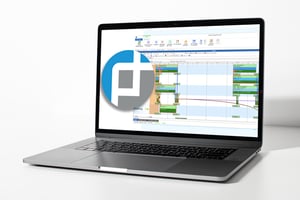Demand Shaping in Scheduling
As a Purchasing Manager, you understand the intricate balance required to meet demand while optimizing resources and minimizing costs in Industrial manufacturing facilities.
In this blog, we look into the concept of demand shaping in manufacturing scheduling, exploring how it can revolutionize your operations and maximize your competitive edge.

What is Demand Shaping?
Demand shaping is a strategic approach to managing demand fluctuations by influencing customer behavior through various means such as pricing incentives, promotions, or lead time adjustments. In the context of manufacturing scheduling, demand shaping involves aligning production schedules with anticipated demand patterns to optimize resource utilization and minimize disruptions.
Traditionally, manufacturing schedules have been reactive, responding to forecasted demand without much flexibility. However, with the advent of advanced scheduling solutions like PlanetTogether, coupled with integration capabilities with ERP, SCM, and MES systems such as SAP, Oracle, Microsoft, Kinaxis, and Aveva, manufacturers now have the tools to proactively shape demand and optimize their production processes.

The Power of Integration
Effective demand shaping relies on seamless integration between scheduling software and existing enterprise systems. Integrating PlanetTogether with your ERP, SCM, and MES systems allows for real-time data exchange, enabling better visibility into demand forecasts, inventory levels, and production capacities.
With this integration, you can leverage historical data, market trends, and customer insights to anticipate demand fluctuations accurately. By aligning production schedules with forecasted demand, you can optimize resource allocation, reduce lead times, and improve on-time delivery performance.
Moreover, integration enables agility in responding to changing market conditions. Whether it's sudden spikes in demand or supply chain disruptions, a connected ecosystem of systems ensures rapid decision-making and adaptation to minimize the impact on production schedules.

Driving Efficiency Through Demand Shaping
So, how does demand shaping translate into tangible benefits for your manufacturing operations? Let's explore some key ways in which it can drive efficiency and enhance performance:
Optimal Resource Utilization
By synchronizing production schedules with demand forecasts, you can better allocate resources such as materials, equipment, and manpower. This prevents overproduction or underutilization of resources, leading to cost savings and improved productivity.
Reduced Inventory Holding Costs
Demand shaping helps in aligning production with actual demand, thereby reducing excess inventory levels. This not only frees up valuable warehouse space but also minimizes holding costs associated with excess inventory, including storage, insurance, and obsolescence.
Improved Customer Satisfaction
By delivering products on time and in line with customer demand, you can enhance customer satisfaction and loyalty. Demand shaping allows you to offer shorter lead times, accommodate last-minute order changes, and respond swiftly to customer preferences, thereby gaining a competitive edge in the market.
Enhanced Supply Chain Resilience
Integration between scheduling and enterprise systems enables better coordination across the supply chain. In the event of disruptions or unforeseen changes, real-time data exchange facilitates quick decision-making and alternative sourcing strategies, ensuring continuity of operations and minimizing disruptions.
Cost Optimization
Overall, demand shaping leads to cost optimization across the manufacturing value chain. By streamlining production processes, reducing inventory carrying costs, and minimizing disruptions, you can achieve significant cost savings while maintaining operational efficiency.

Implementing Demand Shaping Strategies
Now that we understand the benefits of demand shaping, let's discuss how you can implement effective strategies within your manufacturing facility:
Data-driven Forecasting
Utilize historical data, market trends, and customer insights to develop accurate demand forecasts. Leverage advanced analytics tools integrated with your ERP and SCM systems to identify patterns, anticipate demand fluctuations, and optimize production schedules accordingly.
Collaboration Across Departments
Encourage cross-functional collaboration between sales, marketing, production, and procurement teams. By aligning strategic objectives and sharing real-time information, you can develop proactive demand shaping strategies that are responsive to market dynamics and customer needs.
Continuous Improvement
Embrace a culture of continuous improvement within your organization. Monitor key performance indicators (KPIs) related to production efficiency, inventory turnover, and customer satisfaction. Regularly review and refine your demand shaping strategies based on performance metrics and feedback from stakeholders.
Invest in Advanced Scheduling Solutions
Deploy advanced scheduling solutions like PlanetTogether that offer robust capabilities for demand shaping and integration with ERP, SCM, and MES systems. Leverage built-in algorithms, scenario planning tools, and simulation capabilities to optimize production schedules, mitigate risks, and maximize efficiency.
Stay Agile and Adaptive
In today's rapidly evolving marketplace, agility is essential for success. Be prepared to adapt to changing market conditions, customer preferences, and supply chain dynamics. Leverage technology and data-driven insights to make informed decisions and stay ahead of the competition.
Demand shaping is a powerful strategy for optimizing manufacturing scheduling and driving efficiency across your operations. By integrating advanced scheduling solutions like PlanetTogether with your ERP, SCM, and MES systems, you can proactively align production schedules with demand forecasts, minimize disruptions, and maximize resource utilization.
As a Purchasing Manager, embracing demand shaping strategies can help you streamline procurement processes, reduce inventory costs, and enhance supplier collaboration. By leveraging the power of integration and data-driven insights, you can position your manufacturing facility for sustainable growth and competitive advantage in the global marketplace.
Remember, the key to success lies in embracing innovation, fostering collaboration, and continuously refining your strategies to meet the evolving needs of your customers and the dynamic demands of the market. With demand shaping as your guiding principle, you can unlock new opportunities for efficiency, profitability, and success in industrial manufacturing.
Are you ready to take your manufacturing operations to the next level? Contact us today to learn more about how PlanetTogether can help you achieve your goals and drive success in your industry.



